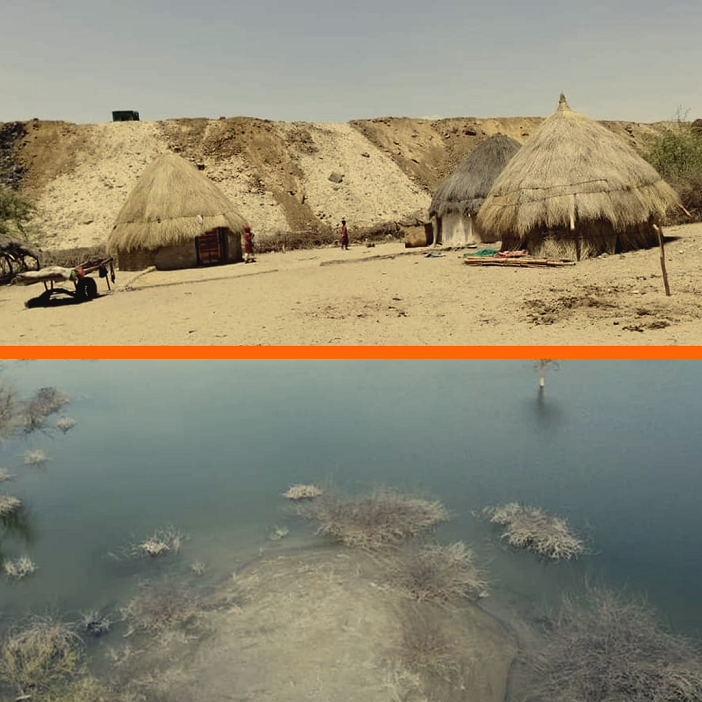The Sindh Engro Coal Mining Company (SECMC) commenced mining operations in Block-II in the Islamkot tehsil of Tharparkar under a joint venture with the Sindh government in 2009-10. This area covers approximately 95 sq km, about one percent of the total coalfield area.
Nine thousand acres of coalfields in the desert have been divided into 14 blocks, out of which coal is being mined from only two of them.
In 2016, it was decided to build a large reservoir near the Gorano village for the water coming out of the Coal Block-II mines. The local people call this artificial lake ‘Gorano Dam,’ which is spread over 1,500 acres.
The local resentment and court cases
The land for this lake was acquired under the Land Acquisition Act, which was contested by the villagers. Meanwhile, there were also complaints about revenue record issues and unresolved properties. But now the local people allege that this reservoir of mining waste (Gorano Dam) destroys the land, underground water as well as the environment. However, the SECMC denies these allegations.
In 2017, Advocate Leela Ram Meghwar, a resident of village Gorano, filed a petition with the Sindh High Court along with the other village residents, calling it an illegal project as the local population was neither taken into confidence nor informed about its pros and cons.
“This wastewater was discharged into a low-lying area between the dunes, which has not been paved and levelled. This will have irreparable environmental, social and economic damage. Hence, the pond should be shifted to a different location,” the petitioners said.
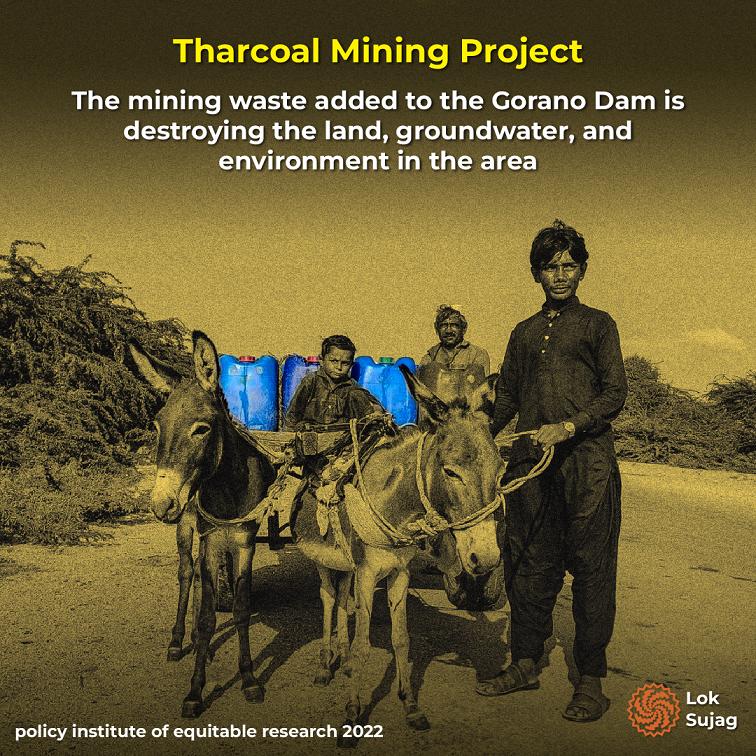
The case went on for six years in the high court and was finally disposed of on June 16, 2023, with the verdict that the laboratory report did not show any environmental pollution. However, the victims have challenged this decision in the Supreme Court.
Drinking water issues
Gorano residents have been protesting against the project for a year in front of the Islamkot Press Club.
Seventy-five-year-old Dhaaru Mal, who is one of the petitioners against Gorano reservoir, says that people in the past used to drink the underground water from the well as it was sweet. However, the dumping of mining waste in the reservoir has made it bitter on an area of five kilometres.
“Twenty-five wells of village Gorano have been closed due to toxic water. The company has replaced them with only one RO (reverse osmosis) plant, which is insufficient for more than 3,500 people who are sulking for potable water now.”
Mal adds that this dam has badly affected the vegetation and trees. Consequently, the local farmers are giving up raising livestock, which is the only source of livelihood here.
The method for coal extraction in Thar is called open pit (or open-cut) mining.
According to the Sindh Thar Coal Energy Board (TCEB), Thar coal retains about 5 to 6.5pc ash, 26 to 33pc volatile matter, 43 to 49pc moisture and more than one percent sulfur.
According to the Chinese-Australian experts in a report of the International Journal of Mining Science and Technology, wherever the top structure of the earth is changed by open-pit mining, leakage of distant water reservoirs occurs due to the pressure of the aquifer. It results in the accumulation of hydrochemical metals and salts in the groundwater.
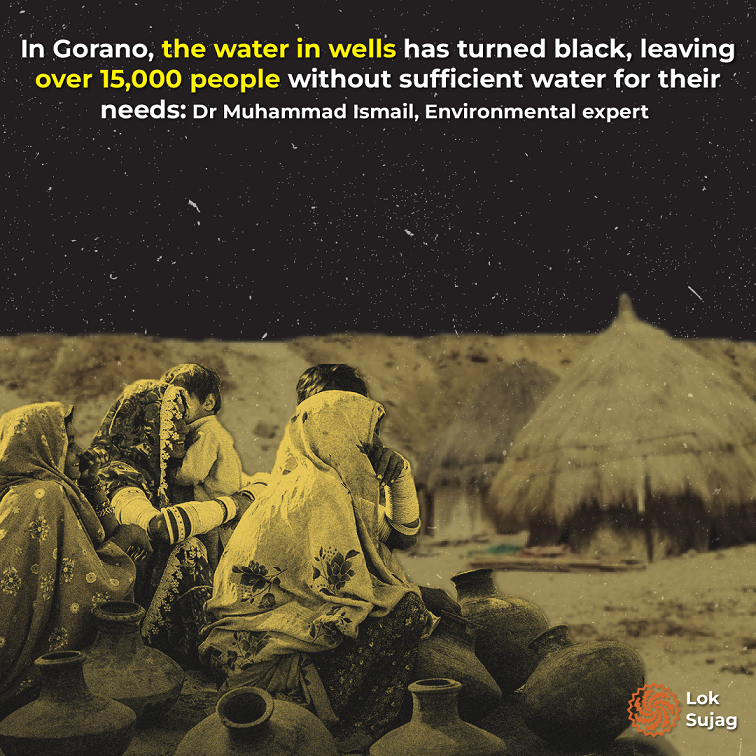
“In New South Wales (an Australian state), open-pit mining has not only caused the watertable to drop by 150 meters or more but the 10 billion cubic meters or more of soil and rock extracted from the mine has also formed a new hill.”
The aquifer and water pumping
An aquifer is an underground layer of rock or soil that is saturated with water.
The SECMC officials say that Thar Coal Block II has three aquifers, of which the first (upper) aquifer is 50 to 100 meters deep, the second and third ones are 150 to 200 meters deep and 200 to 300 meters deep, respectively.
According to the company experts, coal in Thar is sandwiched between the second and third aquifers. It means that there are aquifers on top and below of coal.
Since the coal in Thar is suppressed between two layers of water (aquifers), it is necessary to pump water from the pit, which keeps the mine dry and secure. Therefore, the companies have installed constantly operating submersible pumps at the bottom of the mines, releasing this water into the Gorano reservoir.
In February 2022, a non-government organisation ‘Policy Research Institute of Equitable Development’ (PRIED) published a report on Thar coal power projects.
The report states that heavy metals including arsenic, copper and lead, are released from coal mines along with water. This coal is then washed with chemicals to make it combustible. The discharge of this material is known as ‘acid mine drainage’ which is released into the water reservoir (Gorano).
“Leakage of the reservoir (pond) affects nearby rivers, lakes and aquifer which turns water unfit for drinking and poses a serious threat to public health, local flora and fauna.”
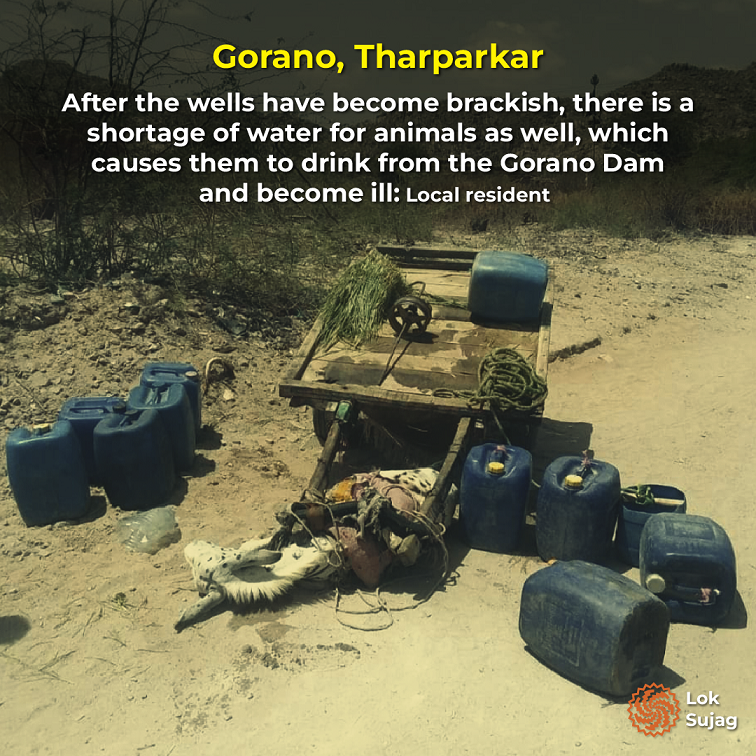
According to this report, the Gorano reservoir will not be enough for wastewater disposal due to the expansion of mining. Hence, a pond has also been constructed in Dhakarchu village. Consequently, the rising volume of wastewater in Thar will impact the quality and quantity of groundwater as well as livestock.
Locals’ protest and official claims
On March 5, a gathering of people from different villages was held near Gorano Dam. It also included the victims of the new reservoir Dhakarchu, which is also contaminated by the same block’s water.
Heero Mal Bheel, a resident of Dhakkarchu village, grows vegetables and fruits with the water of a submersible pump. Being extremely disappointed, he says that now his land will also be ruined like that of Gorano. He had cultivated his land after efforts of day and night and he can’t see his land being destroyed.
Lachhman Das, a resident of Gorano village, mentions that there is also a shortage of water for animals after drying up of the wells, saying the thirsty animals drink water from the Gorano Dam and fall ill.
“I'm sure even the birds that drink this water would die. There is also a risk of livestock drowning as a man drowned here despite the barbed wire around the dam.”
On the other hand, the SECMC insists that the company maintains and strictly adheres to environmental standards.
In response to Lok Sujag’s email queries, the company informed that the Sindh Coal Authority had conducted a detailed assessment of the environmental and social impacts of the water release scheme at Gorano and Dhakkarchu, after which the Sindh Environmental Protection Agency (IPA) issued a no objection certificate (NOC).
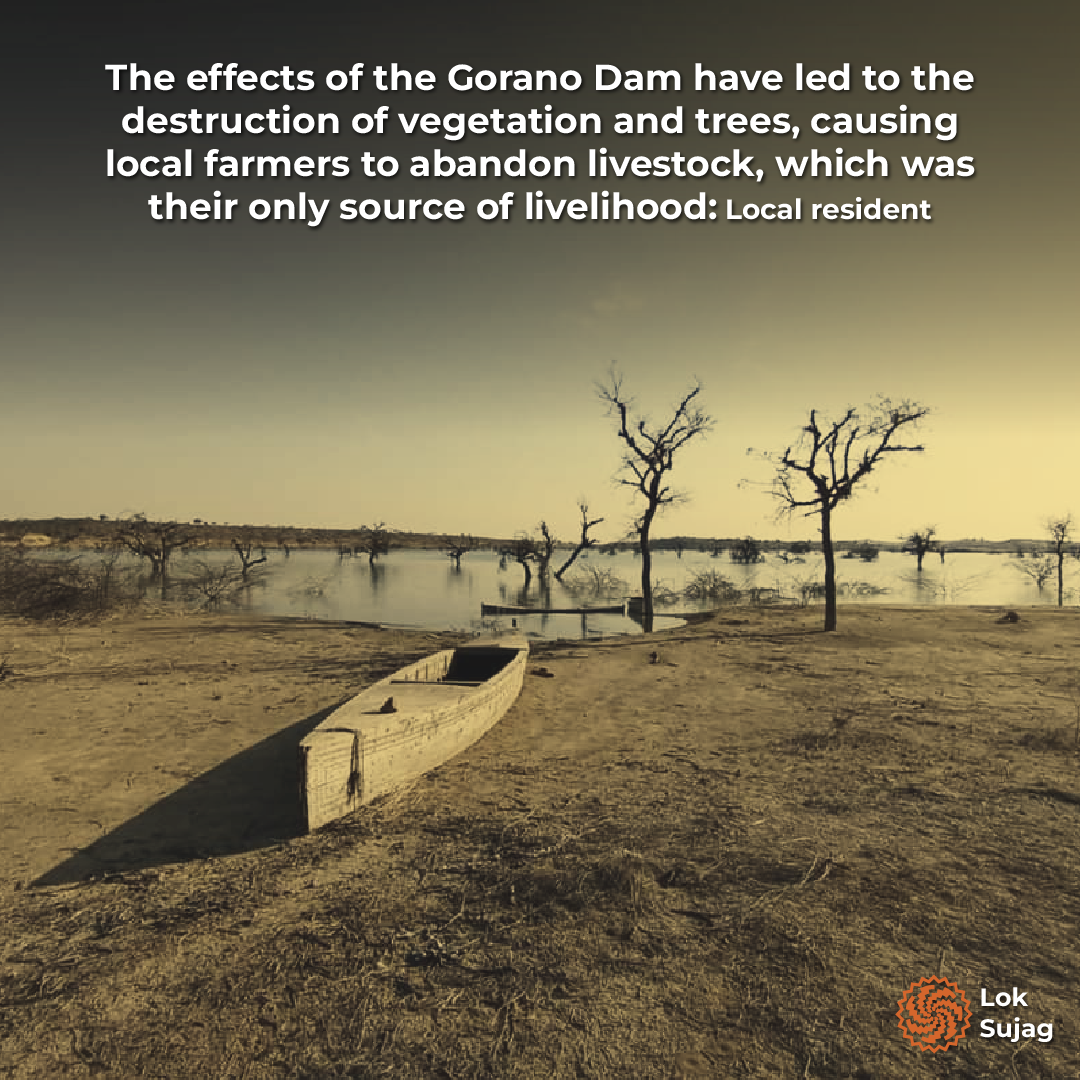
According to the company, an independent environmental monitoring consultant ensures the continuous monitoring and testing of water while its reports are submitted to the IPA every month.
The company officials argue that the Gorano reservoir has been recognised as a better wetland (lake) by the International Union for Conservation of Nature (IUCN). (However, this IUCN report has been subjected to a lot of controversy among non-official experts).
The company also claims that a successful experiment has been carried out for fish farming in this pond. With the support of the Sindh Department of Livestock and Fisheries, it has bred more than 10 fish species that are suitable for human consumption.
However, Bheem Raj, a Gorano resident, corroborates the company’s stand to the extent that fish seed (Poonga) was put into the pond but there were many trees at that time and the water was also fresh.
“Now as there are no trees and the water has become polluted, none of us have seen any fish in the pond.”
He mentions that the two coal mine reservoirs have affected 12 small and big villages along with about 15,000 people whereas only one of these villages ‘Suleman Hijam’ consisting of 16 families has been shifted. However, now there might be a need to move Gorano as well.
According to the mining company, the Thar Foundation is taking sustainable measures for the socioeconomic development of the local population under the CSR (corporate social responsibility) programme.
“It has installed five RO plants in the villages around Gorano pond, which are providing fresh and clean water to the local population.”
Independent environmentalists concerns
Environmentalist Dr Muhammad Ismail Kumbhar, a professor at the Sindh Agricultural University, has undergone a detailed review of Gorano reservoir.
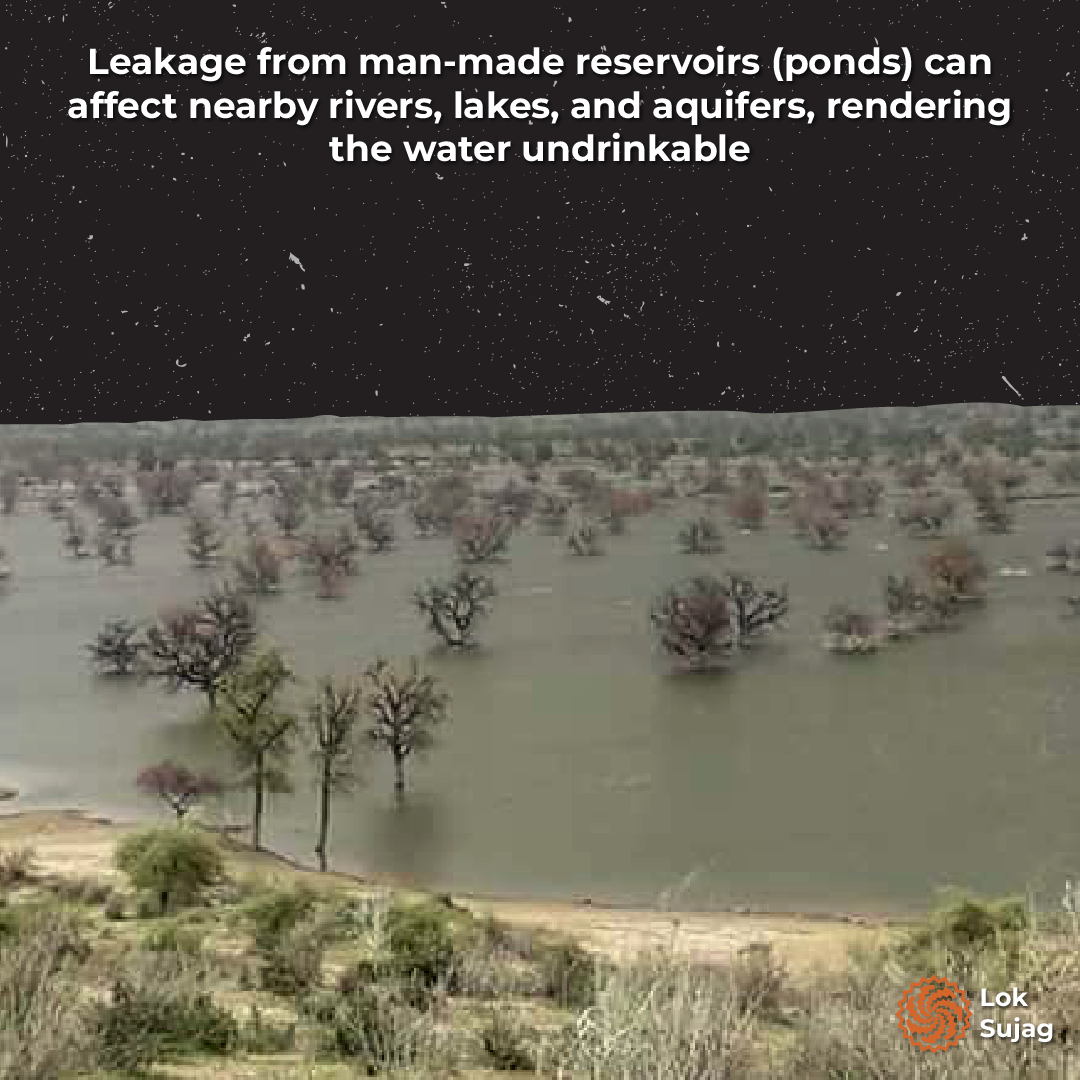
He confirms that the water in the wells surrounding the pond has turned black, due to which more than 15,000 people do not have access to sufficient water while those who consume it contract various diseases.
He says that many plants, including Kanta, Rohiro, Jar, Neem, Berry Kundru, and associated wildlife are dying due to polluted water. The affected areas include around 15 villages and paddies around Gorano while the villages of Sulaiman Hujam, Shojo Thar, Ilha Daya Hujam, and Kulhan Dhani are directly impacted by the pond.
Kumbhar adds that the water coal mining even after treatment does not seem to be able to maintain the environment here. However, it is possible that the sweet water brought from the Nabisar project may be supplied to local people and that companies recycle and reuse water within the plant.
The coal company also claims that before the construction of the Gorano reservoir, it had addressed the genuine concerns of the residents in collaboration with public representatives and local administration. This included the issues such as land compensation, water supply and the provision of basic health and education facilities. However, the residents have registered complaints about not receiving land compensation and basic amenities.
Also Read
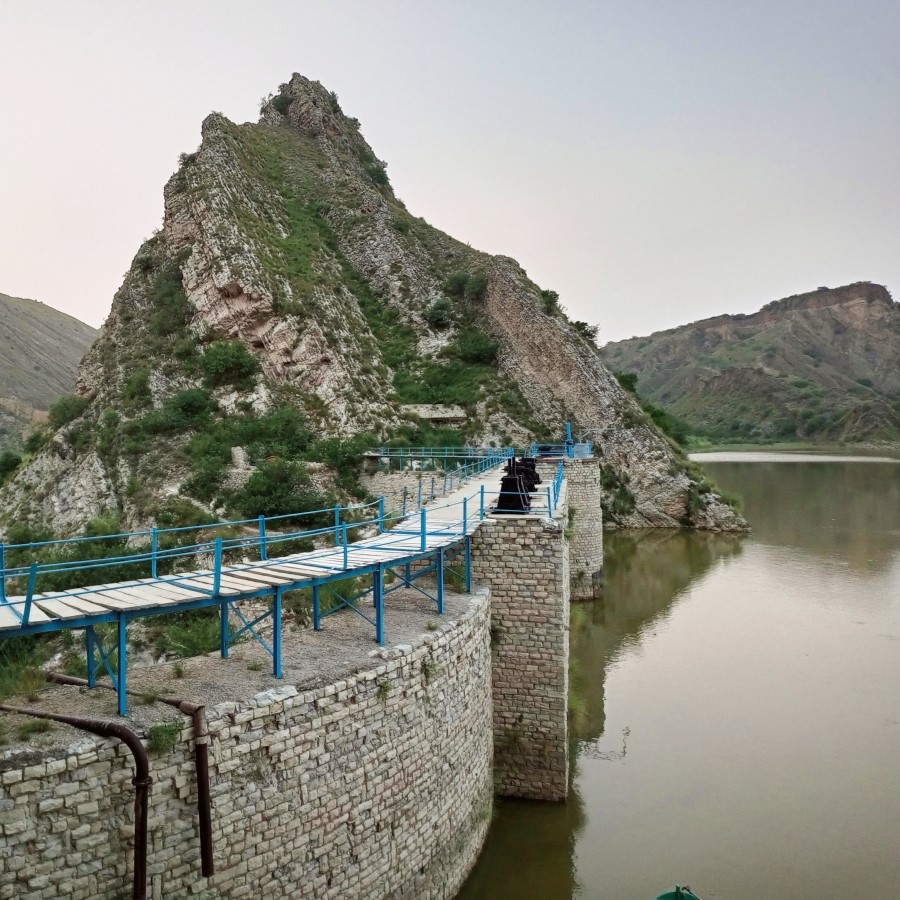
Dwindling waters: Silent struggle of Musa Khel farmers as Namal Dam’s decline threatens livelihoods and ecosystems
Lachhman Das says that the company neither provided any facilities nor did shift the villagers while even drinking water is also not available. Each family gets only two litres of water per day and an annual compensation of Rs10,000, which is insufficient for a living.
Land compensation issues persist
The late Prakho Meghwar was a resident of Gorano village. There was some land in his name as per 'Survey Serial No. 68' which is covered by the reservoir area but the authorities have refused to accept it. The deceased’s son, Chetan, is still waiting for his right to compensation to be recognised.
Panhamal Meghwar is also concerned as his six acres of cultivated land was eaten up by the Gorano dam and he has not received compensation yet.
On Dec 2, 2023, the caretaker provincial cabinet approved more than Rs18m for the compensation to 501 out of 757 families affected by Thar Coal II. However, this amount has not been released yet.
Bheem Raj says the provincial government approved this amount as compensation, which is given annually to each affected household in Gorano village, Rs100,000 per household and it is paid in three installments. However, there is no information available about payments for land prices.
Published on 12 Jun 2024
